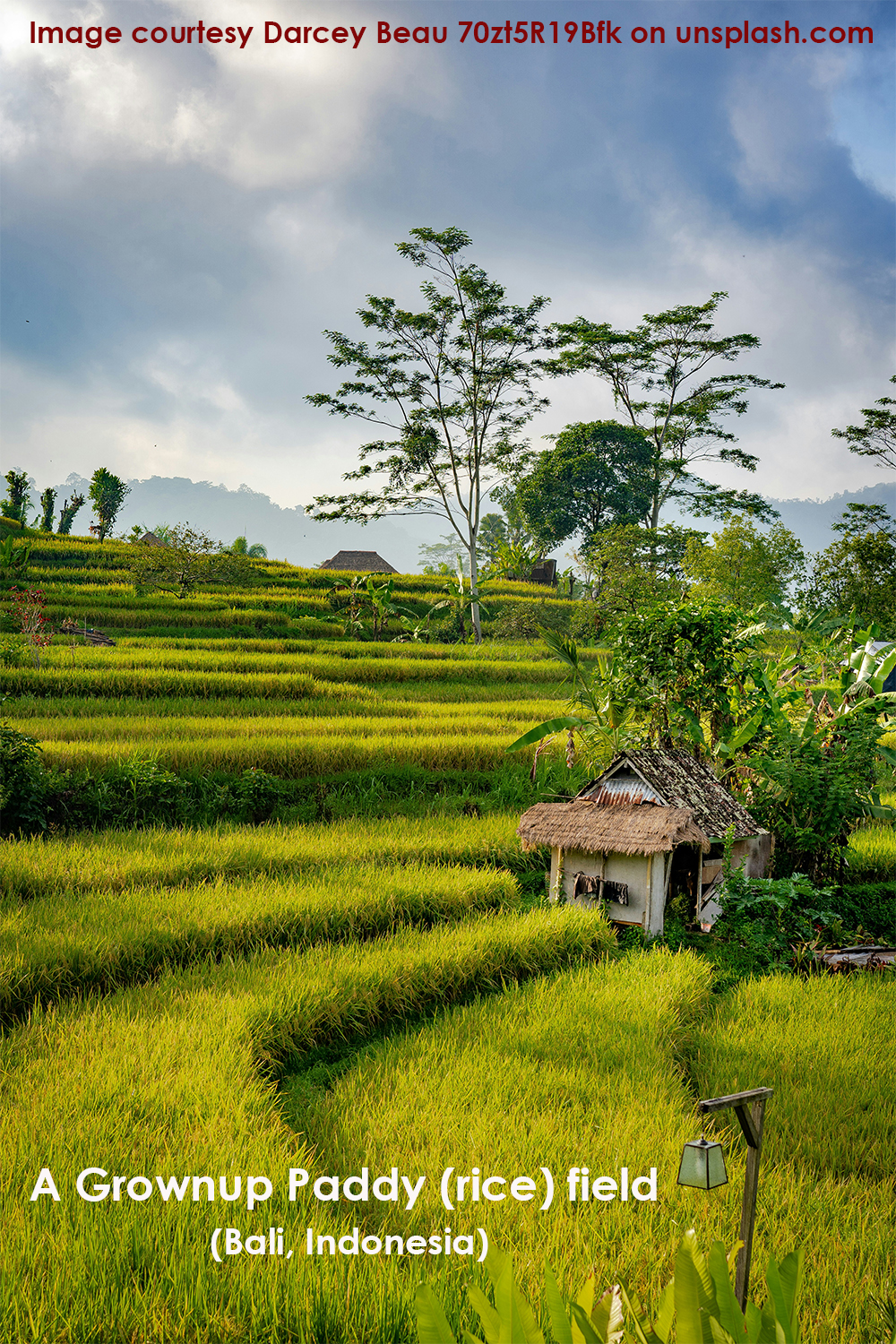Introduction
When you visit the grocery stores, you will find different types of rice, including brown and white rice. Rice is the principal grain of our country. India is the second largest producer of rice, after China, and tops the list of rice exporters.
But, do you know that rice cannot be cultivated directly? Yes, you are correct! You cannot cultivate or implant rice directly and grow it. Paddy is the actual grain and rice is taken out by de-husking the paddy.
Humans’ cultivation and consumption of rice (paddy) might have started more than 5000 years ago. It is the staple food in most Asian countries. It is consumed as a food in many parts of the world.
This article discusses the following subtopics:
- What is brown rice and white rice
- Brown v/s white rice, which is good for you
- Pros and cons of brown and white rice
- How rice (paddy) is cultivated in India
- How paddy is processed into brown and white rice
- Few Frequently Asked Questions (FAQs).
What is brown rice and white rice?
Brown rice is what you get when you remove the hull or husk from the paddy. The hull or husk cannot be eaten by humans. The external layer of the brown rice is called bran.
Brown rice, also called whole grain rice, includes the bran, germ, and endosperm. Although whole grain rice is usually called brown rice, its color can be brown, reddish brown, or black.
When you mill off the bran from the whole grain rice or brown rice, the rice attains a white color. This is called white rice.
Brown v/s white rice, which is good for you
You have understood what is brown and white rice. Let us explore which rice is good for human health and the pros and cons of brown and white rice.
The main difference between brown and white rice is the ‘bran‘. The bran contains un-soluble fibers. The brown rice has the bran and it becomes white when you mill off the bran.
Both brown and white rice are gluten-free. Gluten is a type of protein found in wheat and some other grains. Many people are allergic to gluten.
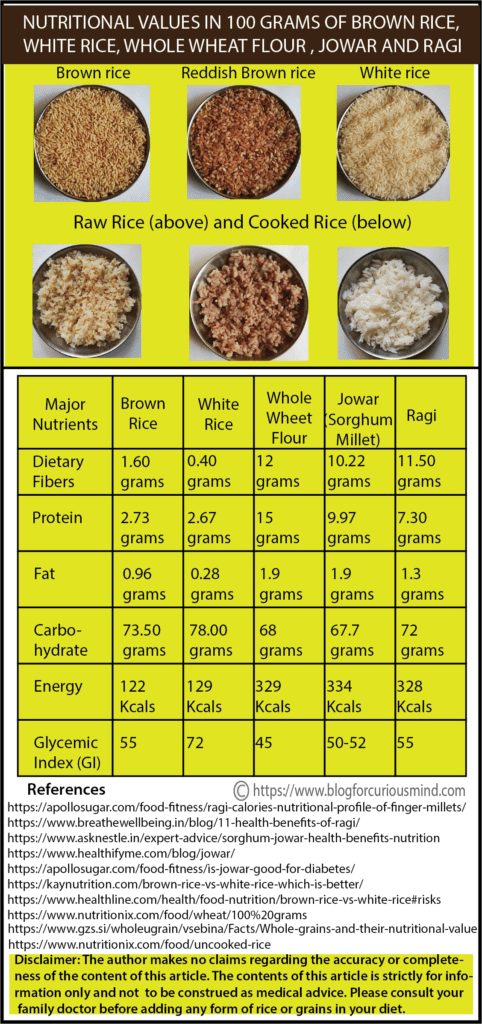
Carbohydrates, in the form of starch, are the main constituent of both brown and white rice. Their other constituents include small amounts of protein, fat, etc. Cooked brown rice has higher dietary fiber, approximately 1.6 grams per 100 grams. On the other hand, cooked white rice has approximately 0.4 grams of dietary fiber per 100 grams.
A higher dietary fiber content in brown rice may help minimize the risk of obesity, high blood pressure, constipation, type 2 diabetes, etc. However, brown rice is not good for people on a low-fiber diet and those who have undergone bowel surgery recently.
Please study the pros and cons of brown and white rice to understand which is good for you.
Pros and cons of Brown and White rice
Brown rice
Pros
- Brown rice is a whole grain rich in dietary fibers and other nutrients, compared to white rice.
- Brown rice has a lower GI Index of 55 while white rice’s GI Index is 72. A lower GI index is favorable to people with type 2 diabetes.
- A higher dietary fiber in brown rice may help minimize the risk of obesity, high blood pressure, constipation, type 2 diabetes, etc.
- Constituents in brown rice like antioxidants, dietary fiber, and minerals may be good for the heart.
- Changing over from white rice to brown rice may be helpful for weight loss and reducing the level of cholesterol.
- However, please seek your doctor’s advice before adding brown or white rice to your diet.
Cons
- Has a low shelf life since brown rice is inflicted by insects faster than white rice, due to the bran content.
- Not good for people on a doctor-recommended low-fiber diet and those who have undergone bowel surgery recently.
- The higher content of phosphorous in brown rice, may not be suitable for people having ailments related to the kidneys.
- Takes more time to cook since it has additional layers of germ and bran.
- As per an authentic source, arsenic can be present in brown or white rice. However, the possibility is more in the bran of the brown rice. The quantum of arsenic present in the bran and its possible risk to human health is still under research.
White rice:
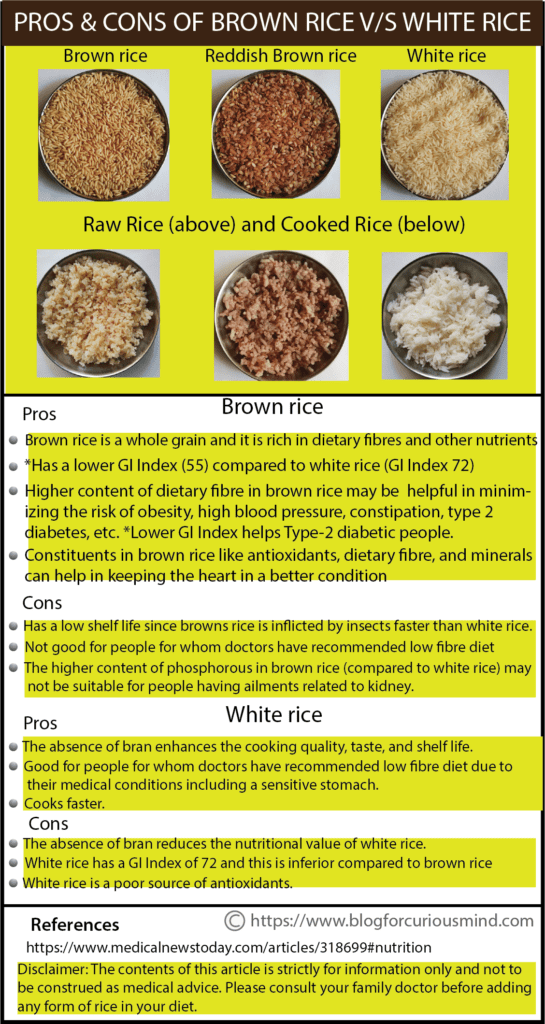
Pros
- The absence of bran enhances the cooking quality, taste, and shelf life.
- Many rice processing mills supplement white rice with nutrients like Vitamin B, iron, and others to compensate for the removed bran.
- Good for people on a doctor’s recommended low-fiber diet due to their medical conditions including a sensitive stomach.
- Cooks faster.
Cons
- The absence of bran reduces the nutritional value of white rice.
- Not helpful in minimizing obesity, cholesterol, type 2 diabetes, constipation, etc.
- White rice has a GI Index of 72. In contrast, brown rice has a GI Index of 55.
- White rice is a poor source of antioxidants.
How rice (paddy) is cultivated in India
Paddy is normally cultivated in areas that receive good rains. And also in areas that receive low to moderate rains and have an alternate source of water. Paddy is known as Kharif or monsoon crop.
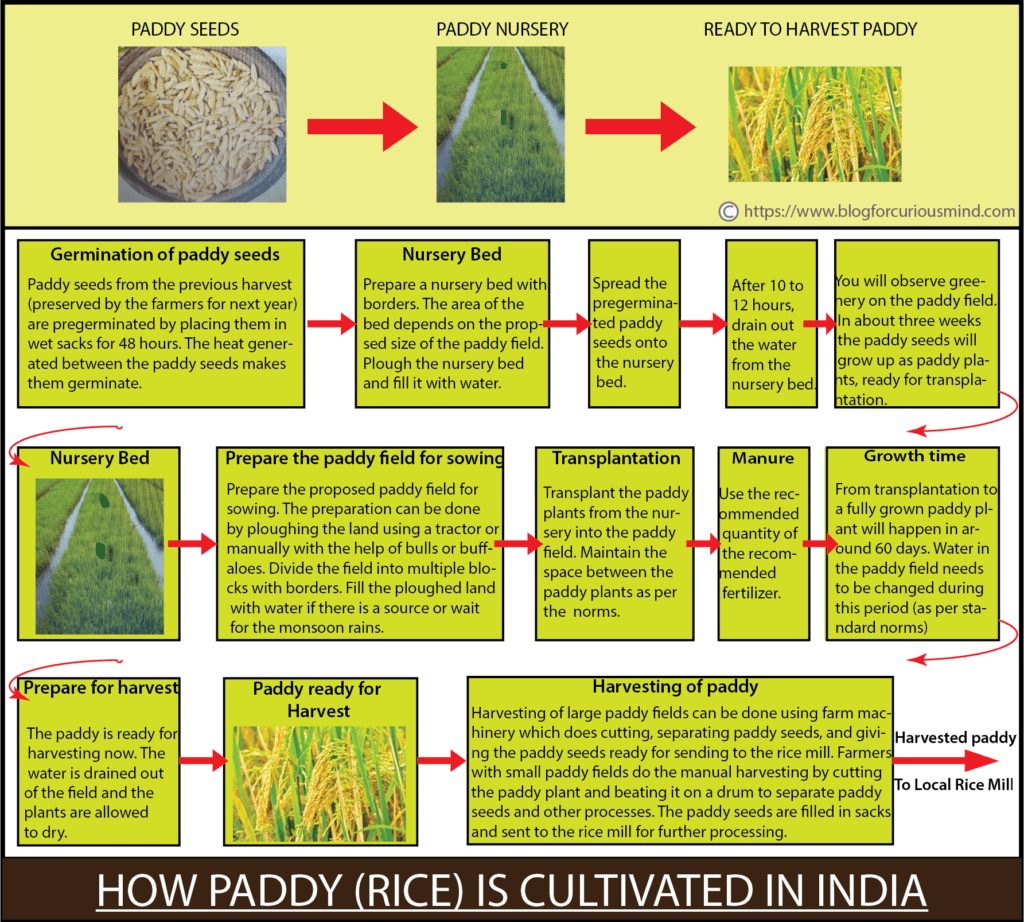
Growing paddy does not need plenty of water. Yet the paddy fields are always filled with water. Do you know the reason?
The real reason is paddy can sustain and flourish despite flooded fields, but the other harmful plants/weeds that try to grow on the paddy fields cannot sustain flooded water and they perish. So, keeping the paddy field filled with water will get rid of unwanted weeds and harmful plants.
Paddy is normally grown in areas that receive good monsoons or where there is an assured source of water. The water in the paddy field is normally changed three times during its growth.
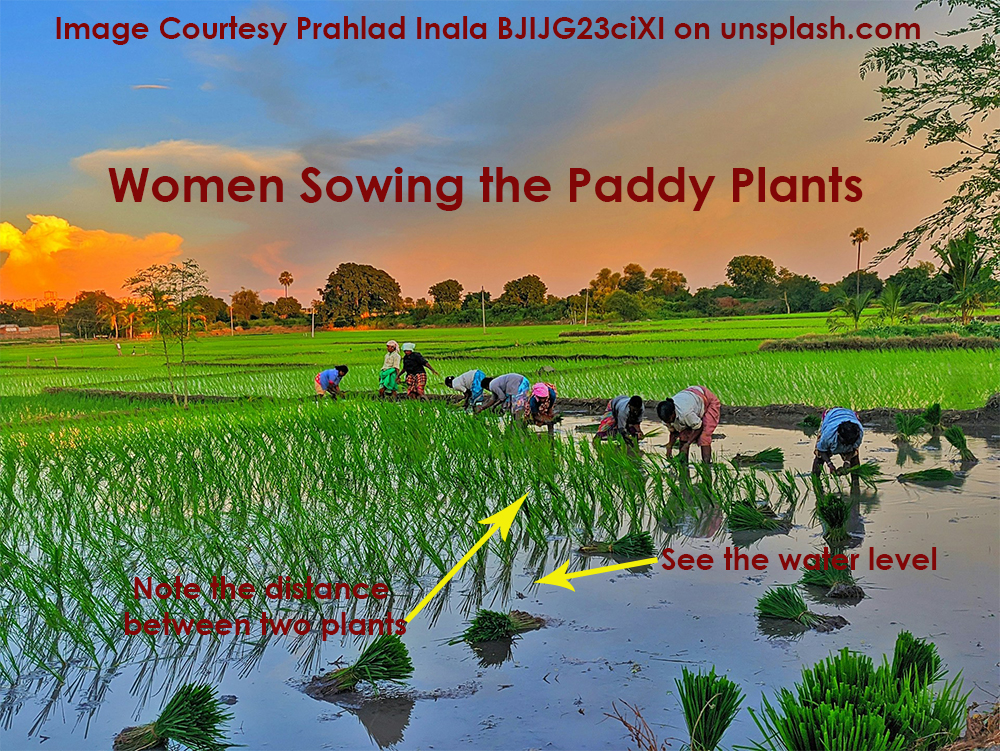
The steps followed for cultivating paddy are:
- Paddy seeds preserved from the previous harvest are pregerminated by placing them in wet sacks for 48 hours. The heat generated between the paddy seeds makes them germinate.
- Prepare a nursery bed with borders. The area of the bed depends on the proposed size of the paddy field. Plough the nursery bed and fill it with water.
- Spread the pregerminated paddy seeds onto the nursery bed.
- After 10 to 12 hours, drain out the water from the nursery bed.
- You will observe greenery on the paddy field. In about three weeks the paddy seeds will grow up as paddy plants, ready for transplantation.
- Prepare the proposed paddy field for sowing. The preparation can be done by ploughing the land using a tractor or manually with the help of bulls or buffaloes. Divide the field into multiple blocks with borders. Fill the paddy field with water if there is a water source or wait for the monsoon rains.
- Transplant the paddy plants from the nursery into the paddy field. Maintain the space between two paddy plants as per the norms.
- Use the recommended quantity of the recommended fertilizer.
- Transplantation to a fully grown paddy plant will normally happen in around 60 days. The water in the paddy field needs to be changed during this period (as per standard norms). The paddy is ready for harvesting now. The water is drained out of the field and the plants are allowed to dry.
- Harvesting of large paddy fields can be done using farm machinery which does cutting, separating paddy seeds, and giving the paddy seeds ready for sending to the rice mill. Farmers with small paddy fields do the manual harvesting by cutting the plant and beating it on a drum to separate paddy seeds and other processes. The paddy seeds are filled in sacks and sent to the rice mill for further processing.
You can view this video (in Hindi) on YouTube.
How paddy is processed into brown and white rice
Paddy is processed in the rice mill into brown and white rice in the following steps:
- Paddy is received at the rice mill.
- The paddy is passed over screens to get rid of pieces of stems that got mixed with the paddy during harvesting.
- Destoning: The harvested paddy can contain medium and small stones and these stones are separated and removed. The cleaned paddy goes to the next stage (de-husking).
- De-husking or de-hulling: In this process, the paddy grains are passed between two rubber rollers rotating in opposite directions. The speed of one rubber roller will be more than the other. The hull or husk of the paddy grains gets removed and the husk and the brown or reddish-brown rice gets separated. The husk is removed and the brown or reddish-brown rice can be used as it is or it can be polished or milled to white rice.
- The brown rice is milled or polished to remove the external layer (bran) to convert it into white rice. The bran is removed either by creating friction between the rice grains or by passing them between rollers.
- The polished white rice will be a mix of broken white rice and whole white rice grains. The broken white rice and whole white rice grains are sorted, separated, and packed separately.
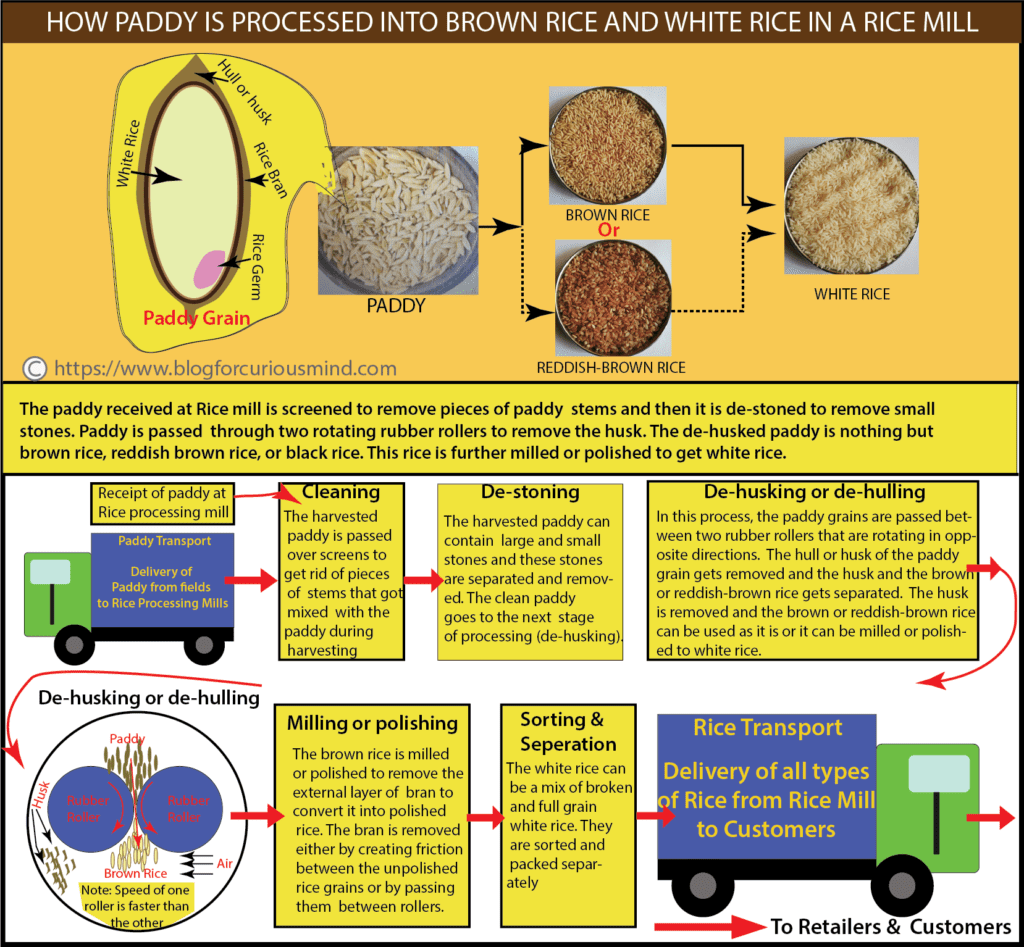
Frequently Asked Questions (FAQ)
What is boiled rice?
Boiled rice is another variety of rice available across grocery stores. Boiled rice has other names like preboiled rice, converted rice, easy-cooking rice, etc. Boiled rice is popular with people living in Coastal Areas.
The difference between boiled rice and other types of rice is the paddy (for boiled rice) is soaked, pre-boiled, dried, and then sent to the rice mill for processing.
The clean paddy is soaked in hot water, boiled using steam, dried, and then sent to the rice mill for processing. Boiled rice can be of two types, boiled brown and white rice. Boiled rice is easier and faster to cook.
Is it safe to consume refrigerator-stored and reheated cooked rice?
Nutritionists do not recommend the consumption of refrigerator-stored cooked rice since it may carry a risk of food poisoning. It is always better to cook the proper quantity of rice and not allow a leftover to happen. Please take the following precautions if there is no alternative to storing the cooked rice in a refrigerator.
- Place the leftover rice in a refrigerator as early as possible, preferably within one hour of cooking.
- Do not store the cooked rice for more than 24 hours.
- Steam the stored rice in a pressure cooker for 5 minutes and consume it steaming hot.
- Do not store or heat it for the second time.
Is it safe to include rice in the daily diet?
Rice is normally considered as a safe staple food. But daily consumption of large quantities of rice may have its own risks. Hence, it is always good to take the opinion of your family doctor and dietician from time to time and follow them.
Consuming too much carbohydrates, whether the source is brown or white rice, may not be good for human health. It is always good to follow a balanced diet.
Some rice mills may add nutrients like Vitamin B, iron, folic acid, and others to the white rice to compensate for the loss of barn.
What is the GI or Glycemic Index?
GI or Glycemic Index is used for categorizing foods containing carbohydrates. The GI index of food explains how fast or slow the said food is digested by the body and elevates the blood glucose levels within two hours. Two hours counted from the time of consuming the said food. The lower the GI index of a food, the higher the time it takes to raise the blood sugar.
What are the names of rice in Indian languages?
India is a multilingual country and it is interesting to know the names for rice in different Indian languages. Names for rice in some of the Indian languages:
- Chaval in Hindi
- Bath in Gujarati, Bengali, and Assamese
- Akki in Kannada
- Thandhul in Marathi
- Arici in Tamil
- Biyyam in Telugu
For more click on this
Conclusion
There can be many arguments about brown rice and white rice and which one is healthier than the other. Some may question the healthiness of the rice itself. Both brown and white rice have carbohydrates. And consuming more carbohydrates may not be good for human health.
A good diet plan should balance all the nutrients required for the human body. And the best person to advise your individual nutritional requirements is your family doctor. Please consult your family doctor before adding brown or white rice to your regular diet.
You may want to read the following articles:
How Poha is made from rice (Paddy)
Caution
The contents of this article are strictly for information and educational purposes only. They are not to be construed as medical advice. Please consult your family doctor before adding any form of rice to your diet.
References
https://www.medicalnewstoday.com/articles/318699#nutrition
https://www.medicalnewstoday.com/articles/319797#which-rice-is-better-in-certain-situations
https://en.wikipedia.org/wiki/Parboiled_rice
https://kaynutrition.com/brown-rice-vs-white-rice-which-is-better/ (add to image)
https://www.healthline.com/health/food-nutrition/brown-rice-vs-white-rice#risks (add)
https://www.nutritionix.com/food/wheat/100%20grams (add)
https://www.asknestle.in/expert-advice/sorghum-jowar-health-benefits-nutrition
https://www.healthifyme.com/blog/jowar/
Is Jowar good for diabetes?

